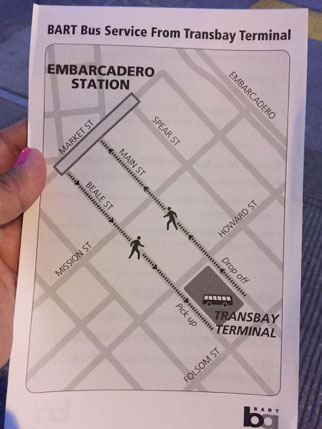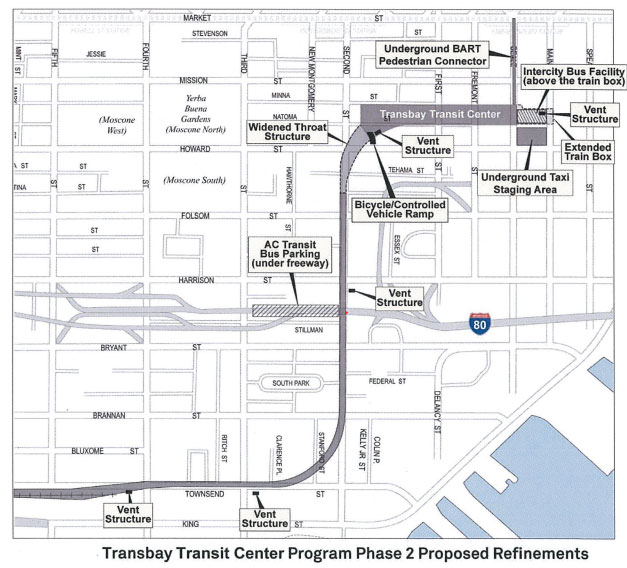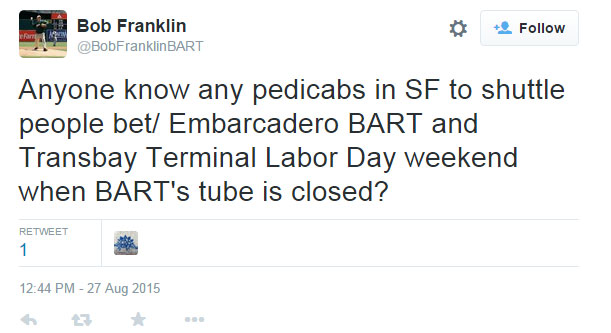BART’s recent weekend closures of the Transbay Tube were happily uneventful: thanks to advanced warning and frequent replacement “bus bridge” service, the closure did not appear to significantly increase traffic congestion or hinder mobility across the Bay. However, while BART deserves credit for orchestrating a mostly-seamless closure, the long connection between the bus bridge at San Francisco’s Transbay Temporary Terminal and BART trains at Embarcadero Station created some frustration among riders forced to walk in excess of ¼ mile to continue their trips. While an inconvenient connection may be tolerable for two weekends, it may serve as a preview for what’s in store for the BART-Transbay Transit Center upon the permanent terminal’s completion.

(Source: Dinah Garcia via Twitter)
The Transbay Transit Center, billed as the “Grand Central of the West,” will soon become one of the busiest intermodal hubs in the country. When it opens in 2017, it will serve Transbay bus services (including AC Transit and WestCAT) Muni services to Treasure Island and elsewhere, Golden Gate Transit service, and Intercity bus services like Greyhound. Caltrain and high speed rail service will eventually serve the terminal as well, hopefully within the next decade. When complete and fully operational, the Transbay Transit Center could serve close to 100,000 passengers daily and will provide a critical regional transfer point, not only for passengers traveling to San Francisco, but also for passengers traveling between the Peninsula/South Bay and the East Bay or North Bay – not to mention passengers accessing high speed rail service to Southern California.
If designed well, the Transbay Transit Center and Embarcadero Station would be close enough to provide a seamless transfer point. The distance of 900 feet between stations would be shorter than the 1,300 feet between the Embarcadero and the Temporary Terminal, but still far enough to necessitate an attractive, efficient underground connection consistent with great transit centers across the world. According to a 2007 report, the pedestrian tunnel would serve over 13,000 daily transfers between transit services (excluding high speed rail) and an additional 34,000 trips for riders traveling to BART or the Transbay Terminal from nearby locations in San Francisco. Without factoring in high speed rail ridership and recent spikes by BART and Caltrain, these estimates are low, but they underscore the need for a pedestrian tunnel connection. Introducing tens of thousands of additional pedestrians onto SoMa’s sidewalks would overwhelm its streets and create an inconvenient connection.
Despite the clear need for a pedestrian connection, there are currently no confirmed plans for its inclusion in the Transbay Transit Center program. A 2007 feasibility study examined several alternative tunnel alignments at a cost between $100-200 million, but noted the following:
“There is currently no funding identified for inclusion of the pedestrian connection tunnel in Phase 1 of the Transbay Transit Center Program. Consequently, it remains a “design option” that would be implemented during the Caltrain Downtown Extension project in Phase 2 of the Transbay Transit Center Program…”
A lot has happened since 2007, but the future of the underground pedestrian connector remains uncertain. As of 2013, several alignments including one under Beale Street remained under consideration, but there are still no firm plans for its implementation. Much of this uncertainty is tied to the frustratingly vague future of the Caltrain Downtown Extension (DTX), which remains unfunded with no clear timeline for implementation. To help resolve the DTX’s funding woes, it’s not inconceivable that the pedestrian connector could be decoupled from the project via ‘value engineering’ to create a more cost-competitive project. Granted, there may already be a solution in the works that is not yet publicly available; however, considering the Bay Area’s history of cutting corners on these lynchpin connections, some skepticism is warranted.

(Source: TJPA, 2013)
If all else fails, BART director Bob Franklin proposed a creative solution for last weekend’s BART closure, although it may be challenging to scale over the long term:



